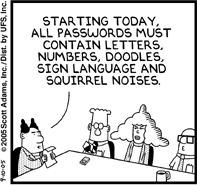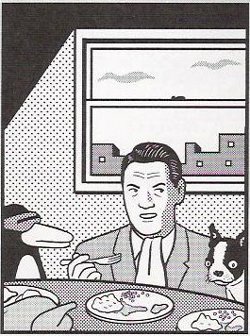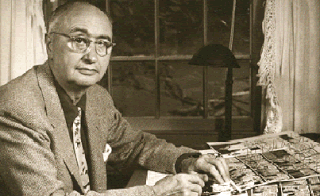Related Research Articles

A comic strip is a sequence of cartoons, arranged in interrelated panels to display brief humor or form a narrative, often serialized, with text in balloons and captions. Traditionally, throughout the 20th and into the 21st century, these have been published in newspapers and magazines, with daily horizontal strips printed in black-and-white in newspapers, while Sunday papers offered longer sequences in special color comics sections. With the advent of the internet, online comic strips began to appear as webcomics.

Dilbert is an American comic strip written and illustrated by Scott Adams, first published on April 16, 1989. It is known for its satirical office humor about a white-collar, micromanaged office with engineer Dilbert as the title character. It has spawned dozens of books, an animated television series, a video game, and hundreds of themed merchandise items. Dilbert Future and The Joy of Work are among the most read books in the series. In 1997, Adams received the National Cartoonists Society Reuben Award and the Newspaper Comic Strip Award for his work. Dilbert appears online and as of 2013 was published daily in 2,000 newspapers in 65 countries and 25 languages.
Chester Gould was an American cartoonist, best known as the creator of the Dick Tracy comic strip, which he wrote and drew from 1931 to 1977, incorporating numerous colorful and monstrous villains.

This Modern World is a weekly satirical comic strip by cartoonist and political commentator Tom Tomorrow that covers current events from a left-wing point of view. Published continuously for more than 30 years, This Modern World appears regularly in more than 80 newspapers across the United States and Canada as of 2015, as well as in The Nation, The Nib, Truthout, and the Daily Kos.

In geometry, an equilateral triangle is a triangle in which all three sides have the same length. In the familiar Euclidean geometry, an equilateral triangle is also equiangular; that is, all three internal angles are also congruent to each other and are each 60°. It is also a regular polygon, so it is also referred to as a regular triangle.

George Joseph Herriman III was an American cartoonist best known for the comic strip Krazy Kat (1913–1944). More influential than popular, Krazy Kat had an appreciative audience among those in the arts. Gilbert Seldes' article "The Krazy Kat Who Walks by Himself" was the earliest example of a critic from the high arts giving serious attention to a comic strip. The Comics Journal placed the strip first on its list of the greatest comics of the 20th century. Herriman's work has been a primary influence on cartoonists such as Elzie C. Segar, Will Eisner, Charles M. Schulz, Robert Crumb, Art Spiegelman, Bill Watterson, and Chris Ware.

In plane Euclidean geometry, a rhombus is a quadrilateral whose four sides all have the same length. Another name is equilateral quadrilateral, since equilateral means that all of its sides are equal in length. The rhombus is often called a "diamond", after the diamonds suit in playing cards which resembles the projection of an octahedral diamond, or a lozenge, though the former sometimes refers specifically to a rhombus with a 60° angle, and the latter sometimes refers specifically to a rhombus with a 45° angle.

In geometry, an isosceles triangle is a triangle that has two sides of equal length. Sometimes it is specified as having exactly two sides of equal length, and sometimes as having at least two sides of equal length, the latter version thus including the equilateral triangle as a special case. Examples of isosceles triangles include the isosceles right triangle, the golden triangle, and the faces of bipyramids and certain Catalan solids.

John Lewis Hart was an American cartoonist noted as the creator of the comic strips B.C. and The Wizard of Id. Brant Parker co-produced and illustrated The Wizard of Id. Hart was recognized with several awards, including the Swedish Adamson Award and five from the National Cartoonists Society. In his later years, he was known for incorporating Christian themes and messages into his strips. Hart was referred to by Chuck Colson in a Breakpoint column as "the most widely read Christian of our time," over C. S. Lewis, Frank E. Peretti, and Billy Graham.

Pearls Before Swine is an American comic strip written and illustrated by Stephan Pastis. The series began on December 31, 2001. It chronicles the daily lives of an ensemble cast of suburban anthropomorphic animals: Pig, Rat, Zebra, Goat, and a fraternity of crocodiles, as well as a number of supporting characters, one of whom is Pastis himself. Each character represents an aspect of Pastis's personality and worldview. The daily and Sunday comic strip is distributed by Andrews McMeel Syndication.

John Burton Davis Jr. was an American cartoonist and illustrator, known for his advertising art, magazine covers, film posters, record album art and numerous comic book stories. He was one of the founding cartoonists for Mad in 1952. His cartoon characters are characterized by extremely distorted anatomy, including big heads, skinny legs and large feet.

Harold Lincoln Gray was an American cartoonist, best known as the creator of the newspaper comic strip Little Orphan Annie.

Keith Edgar Knight Jr. is an American cartoonist and musician known for his accessible yet subversive comic strips The K Chronicles, (Th)ink, and The Knight Life. While his work is humorous and universal in appeal, he also often deals with political, social, and racial issues. Woke, a television series based on his work, debuted in 2020.
Lucky Cow is a syndicated comic strip created by Mark Pett and distributed by Universal Press Syndicate. It focuses around the fictional fast food chain Lucky Cow and its workers. In the strip, the restaurant's advertisements advocate obesity and unhealthy eating habits.
Bonvi, pen name of Franco Bonvicini was an Italian comic book artist, creator of the comic strips Sturmtruppen and Nick Carter.

The Little King is an American gag-a-day comic strip created by Otto Soglow, which ran from 1930 to 1975. Its stories are told in a style using images and very few words, as in pantomime.

Jay Patrick Lynch was an American cartoonist who played a key role in the underground comix movement with his Bijou Funnies and other titles. He is best known for his comic strip Nard n' Pat and the running gag Um tut sut. His work is sometimes signed Jayzey Lynch. Lynch was the main writer for Bazooka Joe comics from 1967 to 1990; he contributed to Mad, and in the 2000s expanded into the children's book field.

Woodrow Gelman was a publisher, cartoonist, novelist and an artist-writer for both animation and comic books. As the publisher of Nostalgia Press, he pioneered the reprinting of vintage comic strips in quality hardcovers and trade paperbacks. As an editor and art director for two-and-a-half decades at Topps Chewing Gum, he introduced many innovations in trading cards and humor products.

In the geometry of tessellations, a rep-tile or reptile is a shape that can be dissected into smaller copies of the same shape. The term was coined as a pun on animal reptiles by recreational mathematician Solomon W. Golomb and popularized by Martin Gardner in his "Mathematical Games" column in the May 1963 issue of Scientific American. In 2012 a generalization of rep-tiles called self-tiling tile sets was introduced by Lee Sallows in Mathematics Magazine.

Lawrence Malcolm Nadle was a comic book editor and writer who was known for his work for DC Comics' romance comics, celebrity comics, and other humor-centric titles. Todd Klein has noted that Nadle's career in comics began "around 1943-44", as an editor for All-American Publications.
References
- ↑ Wolf, Werner (2011). The Metareferential Turn in Contemporary Arts and Media: Forms, Functions, Attempts at Explanation. BRILL. p. 558. ISBN 978-94-012-0069-1.